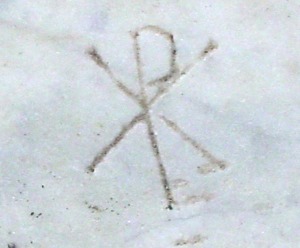“For the stone shall cry out from the wall” – Habukkuk 2:11.
The scrawl on the walls of Pompeii and other ancient sites has been part of their perennial appeal. And, as this selection of graffiti ancient and modern will show, not much has changed in 2000 years. The ancient graffiti were doodled on the walls of Pompeii and Ostia by passers-by or residents in those Roman towns; the modern on the desks in one room of our own Faculty. Thanks to the attendees of Grad Tea on Tuesday for their comments.
Example 1: Squares.
(Ostia)
(Cambridge)
The straight line and right angle, as every schoolboy knows, ‘are the marks which sunder even the simplest civilisation from barbarism.’ (The archaeologist Francis Haverfield, 1913). Well done, Romans and classicists.
Example 2: Religious symbols.
Christian Chi-Rho.
(Ostia)
Christian cross
(Cambridge)
Graffiti like this is often used to suggest the presence of a particular religious group. Does the cross indicate the presence of Christians in the room, or is it just a satisfying and easy shape to inscribe in wood?
Example 3: Philosophy.
“A small problem gets larger if you ignore it.” (Pompeii, the Basilica.)
Example 4: Bilingualism.
Greek text, translates roughly as “Every comer scrawls the walls with his graffiti, the only one who’s written none is me.”
(Ostia)
Greek text, “Oimoi” followed by a capital gamma and “06”, translates as “Alas!”. Looks like Sophocles was a bit too much for “G”.
(Cambridge)
Example 6: Declarations of love.
“Auge loves Allotenus.” (Pompeii, the Basilica.)
Scholars have so far failed to identify “Hunky Nige”, though it is clear that he had a large following.
Example 7: Scurrilous comments.
Latin text, “Hermadion cinaedus”, tr. “Hermadion is a poofter”. (Ostia)
A conversation in two distinct hands: “Paddy does dromesaurs.” “Hot.” “Paddy” seems to be a known character, also found in conjunction with ibises, among other creatures. Hints of a mystery cult? Or Anglo-Irish tensions? The interpretations are endless.
Example 8: Artistic pretensions.
Picture of an elephant, a horse (much smaller, above the elephant), an extremely large mouse. Below the mouse is a juggler, and next to him a helmeted soldier with shield and lance. To the right is a boat.
(Ostia)
Drawing of a seated woman’s back.
(Cambridge)
Example 9: I woz ere.
“Aufidius was here. Goodbye.” (Pompeii, the Basilica)
Two discernible hands: “I was here”, to which another responded “I don’t care”.
(Cambridge)
[Images of the Ostia graffiti sourced from the very excellent ostia-antica.org. Pompeii graffiti from the CIL vol. 4.]













אֵין כָּל־חָדָשׁ תַּחַת הַשָּׁמֶשׁ׃ “There is nothing new under the sun.” – Ecclesiastes 1:9
Sadly so true!
Very nice article!
Thanks! The variety of graffiti in just the one room was pretty astounding. Obviously I haven’t been able to put it all up..
I suggest an emendation to #4: I believe the text in fact reads οἴμοι Γοδ– “oimoi God”–making it a truly bilingual text, with a Greek first word and an eglish word of germanic origin (but written in the Greek alphabet) in the second. This surely provides a fascinating insight into the degree of linguistic assimilation among the inhabitants of G21–the Greek alphabet is clearly a source of prestige, but elements of the original language remains in use. A goldmine for sociolinguists!
Yup, I concur!
The only sad thing is that there were so many interesting things that I didn’t have space to include!
Pingback: Students blogging the classical world | Genetic Inference
Pingback: More classical graffiti – from The Other Place | res gerendae
Pingback: Two Years of Res Gerendae | res gerendae